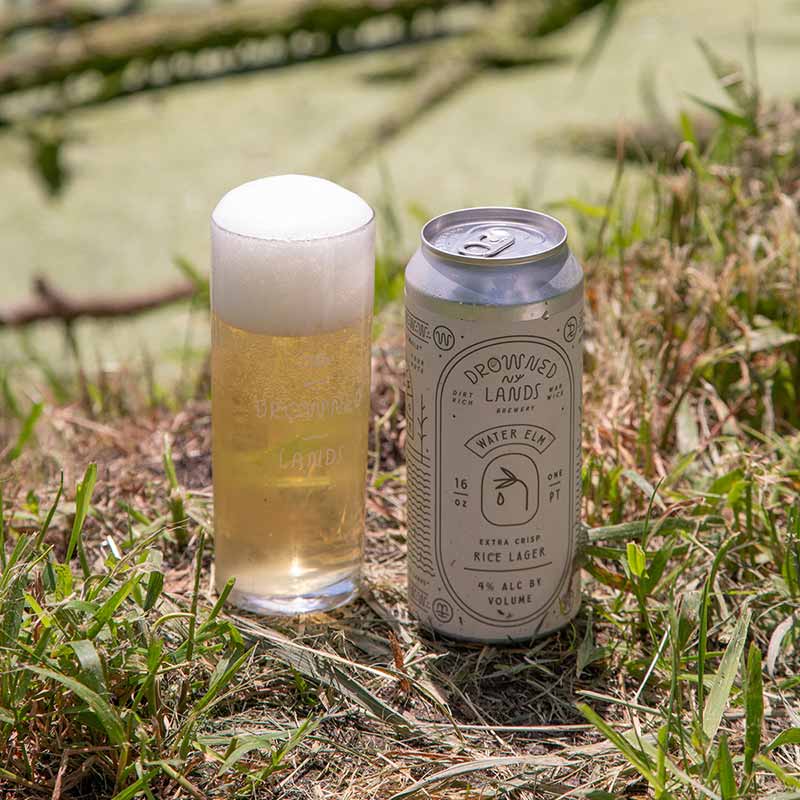
UPDATED: Aug. 4th, 2025
It’s no secret that light lagers are gaining traction within craft beer trends. The style has even climbed up Untappd’s Year in Beer charts, ranking third in 2023, just behind IPAs and stout. When it comes to Japanese rice lagers, specifically, over the last four years, the number of check-ins for the “Lager—Japanese Rice” style on Untappd has increased almost sixty-three percent, from 144,886 in 2021 to 235,665 last year.
The rise even warranted our sister brand, Hop Culture, to predict that 2025 would be the “Year of the Japanese Rice Lager.”
We’ve written about different ways you can make a quality lager—Mexican lager, helles, and Märzen, to name a few. Japanese rice lager is another trending lager variation you can brew to add a low-ABV, drinkable option to your draft list.
We spoke with experts in Japanese rice lagers from Atlanta, GA-based Halfway Crooks Beer and Warwick, NY-based The Drowned Lands Brewery to learn precisely what a rice lager is, how to create a recipe for it, what to know when brewing it, and how to nail the fermentation process.
(Above photography courtesy of The Drowned Lands Brewery)
What We’ll Cover in This Piece:
Affordable, Industry-Leading Brewery Software
How Do the Experts Define Rice Lager?

Photography courtesy of Blake Tyers | Halfway Crooks
“I look for drinkability,” says Halfway Crooks Co-Founder Shawn Cooper.
To achieve that, he says he keeps a simple grain bill and water profile.
“Keep it dry,” Cooper emphasizes. “And have a clean yeast strain—something neutral or with a little bit of sulfur.”
Cooper adds, “The beer is so dry, the bitterness comes through. You want firm bitterness and a crisp, dry water profile. And with that, getting the carbonation up as high as you can is probably a good idea.”
Drowned Lands Founder Mike Kraai says the beer is supposed to be crisp and refreshing. “We are looking for something bright and drinkable,” Kraai says. “We keep the malt character pretty low and soft. I like to think of the beer as delicate.”
Kraai thinks the refreshing element makes it ideal for the summer, though he says they brew theirs all year.
“It’s great in the warm weather, and it’s getting hot, and you’re looking for a refreshing beer,” he says. “I love it for that.”
Kraai adds, “Overall, we are looking for something bright, fresh, refreshing, and soft.”
What Do Experts Feel Are Top Considerations for Making a Great Rice Lager?

Photography courtesy of The Drowned Lands Brewery
Kraai says it is all preference when brewing lagers, but one thing rises to the top for him.
“Water profile is the most important thing,” he says. “We mess around with water profile to be soft and delicate. If you have a ton of minerality—if you over-manipulate it, you’ll have a lot of flavor. We were after clean and soft.”
Kraai adds, “We use twenty ounces of calcium chloride and three ounces of calcium sulfate.”
Cooper agrees that nailing the water is critical to getting the beer dry. At Halfway Crooks, he says they add two parts sulfate to one part chloride in their water. But that all comes down to preference.
Outside the water profile, Kraai preaches simplicity in the mash and a yeast strain that lends a clean fermentation.
“We like to keep our mash temperature low,” he says, at around 149 degrees Fahrenheit. “So it will be a dry, drinkable beer.”
When it comes to the ingredients, Kraai adds the hops on the hot side. Then, “it comes down to time in the tank and cold conditioning,” he says.
Brewers need to find what works for them in terms of malt and hop presence, as well as their finishing gravity.
“It’s a big puzzle,” Cooper says. “High-quality ingredients are important—great hops, malt, and yeast quality.”
Cooper adds, “Tank residency time is important. Carbonation is an important thing. Clarity, tank time, and adhering to top standards for conditioning.”
How to Choose the Right Rice for Your Rice Lager

Photography courtesy of Daniel Paola Alchapar | Unsplash
For Cooper and Kraai, using the right form of rice is essential.
“Rice is there to make it light, drinkable, and dry,” Cooper says, noting while there used to be a time when it was hard to find a good rice product, companies like BSG now carry a variety.
Some options include rice syrup, flaked rice, milled rice, rice extract, rice hulls, or even traditional rice, but the latter includes conducting a difficult process of making a cereal mash where you cook the rice to gelatinize it and stimulate the starches.
“If you’re going to [use traditional rice], you need to know how to cereal mash,” Cooper says. “It is tough to do that.”
Although Cooper notes that they have never been in a position where they had to make their rice lager with a cereal mash, they would do that if all other options were unavailable. Instead, he says they nearly always lean toward flaked rice.
Kraai agrees, noting he prefers flaked rice because it makes brewing a rice lager easier.
“It’s easy to work with and predictable,” he says, “and you know what you’re going to get.”
Kraai cautions not to over-rice the grain bill, though.
“You will get a very distinct color with less rice than you think,” he says. “Don’t overdo it. Less is more. You don’t need a bunch of rice.”
What Is an Ideal Rice Lager Grist Bill?
“We have eighty percent pilsner malt and twenty percent flaked rice,” Cooper says. “We get the mash to sixty-three degrees Celsius to get it dry.”
Cooper says Halfway Crooks does single-infusion mashes for its beer that last forty to sixty minutes, or even longer, as it does its run-off.
The Drowned Lands adds a bit more rice than Halfway Crooks.
“It’s something like thirty percent. That’s the max,” Kraai says. “It’s somewhere in the high twenties [typically], and the other seventy-plus percent is pilsner malt and a touch of white wheat.”
Drowned Lands mashes at around 149 degrees Fahrenheit.
“That cleans up very dry for us,” Kraai says.
What Is the IBU Sweet Spot for Rice Lager?
Cooper says he likes a nice hop profile in their rice lager.
“The way we do it, we do a huge whirlpool addition and work our way backward,” Cooper says. “We look at total oil content and base the bitterness on the whirlpool hop.”
Cooper says they use irrigated Saaz hops from Germany throughout their brew process.
“Probably generally around twenty-three or so IBUs on the hot side,” he says. “If you measure it out after the fact, it’s around thirty IBUs.”
He adds they do several doses of the Saaz in their rice lager.
“The sixty and forty additions are determined on IBUs,” Cooper says. “Then the ten-minute and whirlpool is based on total oil.”
Kraai says they hardly bitter at all in their rice lager.
“We use Hallertau hops,” Kraai says. “We maybe do a five-minute addition, though this last one we did was whirlpool.”
He adds, “It’s just a pinch of bitter. We are more looking for a nice, delicate beer. It’s a very clean beer. It’s so simple. We have plenty of beers with a bouquet of flavors, and this is not that beer for us.”
What Is the Fermentation Process for Rice Lager?

Photography courtesy of The Drowned Lands Brewery
Kraai says the fermentation process can have a wide range depending on your needs and equipment.
“This beer would benefit from more time,” Kraai says. “We do this a little faster. We typically package in six weeks; the centrifuge helps that a lot. Probably without, it would be a seven- or eight-week beer.”
Kraai adds, “If you want [it to be] more soft, it could be a three-month lager.”
Cooper stresses the need for tank residency to nail this beer.
“At least six weeks,” he says. “We tend to have one and a half to two weeks of fermentation based on yeast health. Then transfer to [the] lager tank and sit for at least four weeks.”
Cooper says some do it in three months, and some use centrifuges to speed up fermentation, but the turnaround time that makes the most sense for him is a month to month and a half.
“We find four to six weeks is when it tastes best,” he says. “There are a lot of factors to determine how long the tank residency [will be].”
Both Kraai and Cooper say they ferment with lager yeast—namely W-34/70. Ultimately, the beer has to be approachable and drinkable, so that means low ABV.
Kraai says it’s doubly important for them to have low ABV.
“We are located in a 700-acre park. Everyone that comes here is coming to us. And everyone has to drive home, so it’s important to have multiple low-ABV beers,” Kraai says. “I love this beer at 4% ABV. You can drink two, three, four of them and still drive home.”
Kraai adds, “It’s almost like farmhouse style, meant to be nourishing. I like low ABV. I wouldn’t mind even doing one a little lower. I wouldn’t find it offensive doing a 4.5% ABV.”
Cooper says the range for rice lager is 4.8% ABV to 5.2% ABV, but “we like to be in the lower range of that spectrum.”
Two Examples of a Great Rice Lager

Photography courtesy of The Drowned Lands Brewery
Halfway Crooks has Super Super Turbo Turbo, a 5% ABV version that Cooper describes as “super cold, super dry.”
“It’s all about process. It’s how you treat the beer and your process and control at the brewery,” Cooper says. “We pay attention to every part of the brewing process. The recipe is rather simple … but it’s a lot of attention to detail.”
Drowned Lands has its 4% ABV Water Elm. Kraai strongly believes their process and execution make for a great take on the style.
“For us, we just wanted a clean beer that had clean fermentation and mash, and it’s a clean beer,” he says. “There’s nothing harsh about it.”
Kraai adds, “It appeals to a large audience of people. This is an approachable beer for everyone. … If you like beer, this is a good beer.”



